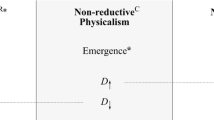Abstract
In The Self: Naturalism, Consciousness and the First-Person Stance (Oxford University Press 2012), Jonardon Ganeri draws on the ancient Indian Cārvāka philosophy to delineate a “transformation” account of strong emergence, and argues that the account adequately addresses the well-known “causal exclusion problem” formulated by Kim (Supervenience and mind. Cambridge University Press, Cambridge, 1993; Mind in a physical world: an essay on the mind-body problem and mental causation. MIT Press, Cambridge, 1998; Philos Stud 95:3–36, 1999; Synthese 151:547–559, 2006). Ganeri moreover suggests that the transformation account is superior to the enactive account of emergence, developed by Francisco Varela and Evan Thompson (Varela et al. in Embodied mind: cognitive science and human experience. MIT Press, Cambridge, 1991; Thompson and Varela in Trends Cogn Sci 5:418–425, 2001; Thompson in Mind in life: biology, phenomenology, and the sciences of mind. Belknap Press, Cambridge, 2007) for the latter merely “sidesteps” the exclusion problem (Ganeri in The self: naturalism, consciousness, and the first-person stance. Oxford University Press, Oxford, 2012: ch. 4, footnote 9). In this commentary, presented in an “author meets critics” panel at the Pacific APA 2016, I suggest that, contrary to Ganeri’s claim, the enactive account does not merely sidestep the causal exclusion problem—the response the enactive account can offer is actually highly similar to the response offered by the transformation account.
Similar content being viewed by others
Notes
In addition to distinguishing transformation emergence from enactive co-emergence, Ganeri also distinguishes it from Shoemaker’s account of emergence, which, unlike the transformation account (analogous to fire), is analogous to tornado (see Ganeri 2012: 94); Ganeri also distinguishes the transformation account from Humphreys’s (1997) account of fusion emergence due to Humphreys’s eschewal of the supervenience thesis.
The operation + reflects the “blending” interaction among the elements (Ganeri 2012: 85).
Ganeri does not specify the modal strength of this supervenience relation in chapter 4 of The Self. Importantly, however, he suggests that the inclusion of the supervenience relation distinguishes the transformation account from Humphrey’s (1997) fusion account as well as other non-supervenience-based accounts of strong emergence.
Once transformed, the T(ei)’s are supposed to have new causal powers “conditionally upon their membership of the whole” (i.e., {e1 + e2 + e3}) (Ganeri 2012: 86).
As does Jaegwon Kim (see O'Connor and Wong 2012), Ganeri understands a mental event as an instantiation of some mental property at a time.
The mental causal influence may also be understood as an iterative or recursive process, making the transformation process non-linear. Such non-linearity is often taken to be an indication of emergence in complex, dynamical systems (Thompson 2007). Broad’s original proposal of such “trans-ordinal” laws was also meant to reflect a key epistemological status of emergent phenomena: they are often not precisely predictable because the trans-ordinal laws can only be in place upon the first instance of the emergent feature (Ganeri 2012: 91; O'Connor and Wong 2012).
In other words, no new elements are required for the emergence of mentality—elements only have to be transformed for such emergence. This result adheres to Ganeri’s intuition that ‘nothing new can come into existence’ (84), which may reflect a ‘hard naturalistic’ metaphysics.
That is, the combination mapping C is one-to-one and onto (i.e., bijective).
This is reflected in the formulation of the C-mapping as bijective.
It might be useful to remind that P and P* relate to each other in a homopathic way.
See also footnote 24 in Ganeri (2011).
Conditions (1) and (2) are supposed to be necessary in Thompson and Varela’s definition of emergence, while a third condition—relational holism—is regarded as a possible condition: viz., the emergent processes (and their emergent properties) are “not exhaustively determined by the intrinsic properties of the components” of the network (Thompson and Varela 2001).
References
Dretske, F. (1993). Mental events as structuring causes of behavior. In J. Heil & A. Mele (Eds.), Mental causation (pp. 121–136). Oxford: Clarendon Press.
Dupré, J. (1993). The disorder of things. Cambridge, MA: Harvard University Press.
Ganeri, J. (2011). Emergence, ancient and modern. Mind, 120(479), 671–703.
Ganeri, J. (2012). The self: Naturalism, consciousness, and the first-person stance. Oxford: Oxford University Press.
Hattiangadi, J. (2005). The emergence of minds in space and time. In D. M. Johnson & C. Ernelling (Eds.), The minds as a scientific object: Between brain and culture (pp. 79–100). New York, NY: Oxford University Press.
Humphreys, P. (1997). Emergence, not supervenience. Philosophy of Science, 64, 337–345.
Juarrero, A. (1999). Dynamics in action. Cambridge, MA: MIT Press.
Kim, J. (1993). Supervenience and mind. Cambridge: Cambridge University Press.
Kim, J. (1998). Mind in a physical world: An essay on the mind-body problem and mental causation. Cambridge, MA: MIT Press).
Kim, J. (1999). Making sense of emergence. Philosophical Studies, 95, 3–36. Repr. in Bedau and Humphreys (2008: 127–54).
Kim, J. (2006). Emergence: Core ideas and issues. Synthese, 151(3), 547–559.
Kronz, F., & Tiehen, J. (2002). Emergence and quantum mechanics. Philosophy of Science, 69(2), 324–347.
O’Connor, T., & Wong, H. Y. (2012). Emergent properties, In N. Z. Edward (Ed.), The stanford encyclopedia of philosophy (2012 Edition). http://plato.stanford.edu/archives/spr2012/entries/properties-emergent/.
Searle, J. R. (2000). Consciousness, free action and the brain. Journal of Consciousness Studies, 7(10), 3–22.
Shoemaker, S. (2007). Physical realization. Oxford: Oxford University Press.
Silberstein, M., & McGeever, J. (1999). The search for ontological emergence. The Philosophical Quarterly, 49(195), 182–200. doi:10.2307/2660261.
Thompson, E. (2007). Mind in life: Biology, phenomenology, and the sciences of mind. Cambridge, MA: Belknap Press.
Thompson, E., & Varela, F. (2001). Radical embodiment: Neural dynamics and consciousness. Trends in Cognitive Sciences, 5(10), 418–425.
Varela, F., Thompson, E., & Rosch, E. (1991). Embodied mind: Cognitive science and human experience. Cambridge, MA: MIT Press.
Author information
Authors and Affiliations
Corresponding author
Rights and permissions
About this article
Cite this article
Wu, R. Transformation emergence, enactive co-emergence, and the causal exclusion problem. Philos Stud 174, 1735–1748 (2017). https://doi.org/10.1007/s11098-016-0838-5
Published:
Issue Date:
DOI: https://doi.org/10.1007/s11098-016-0838-5




